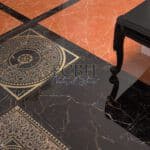

A Go-To Guide for Choosing the Right Marble
Feeling overwhelmed by the numerous choices you have for anything from flooring to paint colour to countertops while working on a remodel or new construction project?
This is the most complete guide about choosing marbles. Everything you need to know about selecting the best marble material, including aesthetic, durability, pricing, and even health factors, is covered in this guide.
The best option will depend on the area’s anticipated traffic and intended use, your own preferences, and your budget. The key to a project’s success is finding the right team to help with selection, design, and installation.

Fortunately, this guide will assist you in choosing the appropriate materials and locating the specialists to bring your vision to life, allowing you to take pleasure in your finished space for years to come.
This manual is suitable for you whether you’re upgrading a luxurious bathroom, living room, or constructing a full house.
If you’re like most people, you spend a lot of time in the kitchen or bathroom at home. We invest a lot of our energy in these rooms, whether it be for cleaning, entertaining, getting ready for the day, or cooking. You will find all the information you require in this guide to choosing the marble that best suits your home, office, or commercial center.
Table of Contents
Chapter 1
HOW DOES THE STONE LOOK?
The kind of stone you select could affect whether or not you notice seams, whether the pattern is regular or irregular, and whether or not the appearance might vary over time. Natural stone as opposed to artificial (man-made) stone is one of the most important aspects of attractiveness. Some of the most popular natural stones are listed below:

Crema Marfil

Red Alicante

Dark Emperador

White Macael

Yellow Alhambra
& Triane

Grey Macael

Black Marquina

Gold Emperador
Natural stone is just that, 100% organic. It is quarried from the earth in large blocks which are then sliced into slabs and polished on one side. Natural stone is unique, no two slabs are alike, which gives every project an original look. For this reason, it is very important to work with a supplier so that you can rely on the selection of marble tiles and slabs for your project to acquire tone-matching marbles.
Find the perfect color for your marble surface.
Chapter 2
MAINTENANCE AND DURABILITY
Marble Can Be Sealed
Marble is sometimes regarded as being high maintenance. Actually, marble requires approximately the same amount of upkeep as any other countertop you want to maintain top condition.
Since there are several kinds of marble, it is best to consult with us. The majority of marble, however, needs a seal In most cases, this marble shouldn’t need to be sealed again.
Another widespread misconception is that marble needs to be resealed annually to maintain its porous surface. However, this is simply untrue. You might need to get it resealed at some time, depending on how frequently you use it and how well you maintain your counters. However, routine maintenance and care should keep your sealant in place. You may prevent this by always using cutting boards, using towels for hot dishes, and mopping up spills as soon as they happen.
Marble Is Perfect for Baking
A marble countertop’s smooth, cool, and firm surface is one of its best features. It certainly has a beautiful appearance in your home, but it was also made to withstand some serious baking.
You can simply use your marble countertop for tasks like rolling out dough, cooling cookies, and letting pies rest thanks to this cool, hard surface. It provides you with a pleasant, smooth surface to work on and prevents the components or dough from melting as you try to utilize it.
Although it’s not a good idea to use a cookie cutter directly on your marble surface, you can certainly use the surface to host dinner parties.
Marble Can Be Very Strong
It is simple to understand why some people believe marble is not a durable material for a countertop. Considering that marble is a soft stone, A marble countertop can develop dents, scratches, and other blemishes on its own.
However, thanks to current technology and top-notch construction firms, the majority of countertops are made with the right measures that shield the marble from these flaws. Avoiding scratches can be made easier by selecting a honed finish.
Similar to how correct daily use and care will keep your countertops looking good for much longer. This entails using cutting boards, preventing dropping kitchen tools, and handling knives with great care.
You can be sure that your marble countertop will last a lifetime if you use high-quality marble, an excellent sealer, professional installation, and routine maintenance.
You can choose the material for your countertops based on appearance, but maintaining this stone is also crucial because you will use it every day. It’s crucial to consider how you’ll use your countertops when you assess the stone that would work best for you. The five significant questions covered in this chapter will assist and guide you in the proper route.
Question 1: Do I want to put hot pots and pans directly on my countertops?
- Although you can generally place hot items on a marble countertop without worrying about any major damage, it’s best to play it safe. In reality, placing pots and pans directly on marble is more likely to cause scratching than cracking, discoloration or yellowing.
Question 2: What will happen if I spill on my countertop or marble floor?
- With any spill, a quick clean-up is a good idea, but some materials will be more forgiving than others.
- Marble can be sensitive to certain oil and high acidic based products.
- Depending on the stone, you may be able to apply a special paste called a poultice, made of liquid cleaner mixed with an absorbent material, to pull the stain out.
Question 3: What if I drop a heavy object on my marble? Will it chip or scratch easily?
- Marble is not as durable and should be treated with care, similar to a fine wood countertop.
Question 4: Do I need to seal my stone? If so, how often?
- Professional sealing will increase stain resistance and prevent moisture absorption. If you decide to seal your stone, once every 10 years by a professional is the recommended increment.
Question 5: What does routine maintenance of my stone look like?
- There are a variety of natural stone cleaners on the market that can be used for many of these countertops.
- Another option is even easier and less expensive – mild dish soap diluted with water used with a cotton cloth or soft sponge. The final step would be drying with a soft cloth to eliminate streaks and leave the surface with a sparkling shine.
- It is important not to use an abrasive scrubber, especially on any surface that is prone to scratches.
Now that you are thinking about the maintenance of your countertop, the next logical question is what is the traffic like in the area I’m considering installing this? A high-traffic area may have a much different “right” stone than a low-traffic guest bathroom or butler pantry. In the next chapter, we’ll explore the variety of applications for marble and how that will factor into your decision.
Have more questions? Have a look through our FAQ.
Chapter 3
CHOOSING THE STONE TO FIT YOUR APPLICATION
When choosing a stone, it’s important to take into account where it will be used. For example, you might choose a stone that requires more upkeep for a low-traffic area, while you’ll probably want to choose something more durable and low-maintenance for your high-traffic region. A crucial component of picking a decision you’ll love for years to come is considering the expected traffic and use of your space with us.
Step #1: Consider the use of the area.
- Will you be preparing food in the area?
- Will you use cleaning liquids on the surface regularly?
- Will you be using the marble for high traffic environment?
Step #2: Consider the traffic in the area. Will this be a heavily used room or a location that has lower use and you are aiming for high style?
In Chapter 1, we talked about the appearance of stone and the unique patterns that natural stone options offer. If you are looking for a unique pattern and aren’t overly concerned with seams, or working with a small space, you could consider a wide variety of options. Based on what we’ve learned about maintenance if this is a low-traffic area your choices are unlimited with marble as you are aware of the minor ongoing potential maintenance needs. If you are looking for pattern and uniqueness but know the area will be heavily used or want a lower maintenance solution, granite is an excellent choice.
Step #3: Is the marble for indoors or outdoors?
In addition to being important for creating the foundation of your outdoor space, selecting the right flooring is also crucial given the weather and wear and tear it will experience. While marble is frequently used as flooring in indoor places like bathrooms and kitchens, it can also be a beautiful and practical choice for outdoor spaces.
We provide as much detail as possible in our ECBH Natural Stones product description for each and every marble possible.

Chapter 4
PROPERTIES OF NATURAL STONE MARBLE
Marble can be classified into four groups A, B, C, and D. These groups indicate fabrication ability, based on the level of hardness. Marble also comes from the earth, it is a metamorphic stone formed from recrystallized carbon. It is formed when limestone is subjected to intense heat, pressure, and chemical solutions, due to shifting in the earth’s crust. Marble is formed from very pure white limestone, while the presence of other minerals, such as clay, silt, and sand, can give it richly varied coloration. Marble is typically found in mountainous regions, and there are hundreds of quarries in Spain, to provide exquisite Spanish marble worldwide.
Learn different applications
in residential and commercial areas.
WHICH MARBLE IS RIGHT FOR YOU?
Please share your thoughts along with information on your project and which Spanish marble you chose by contacting us below.
Add a comment Cancel reply
Comments (0)
Categories
- All (20)
- Marble Guides (10)
- Marble Locations (22)
- Press Release (2)
Recent Posts
About us












